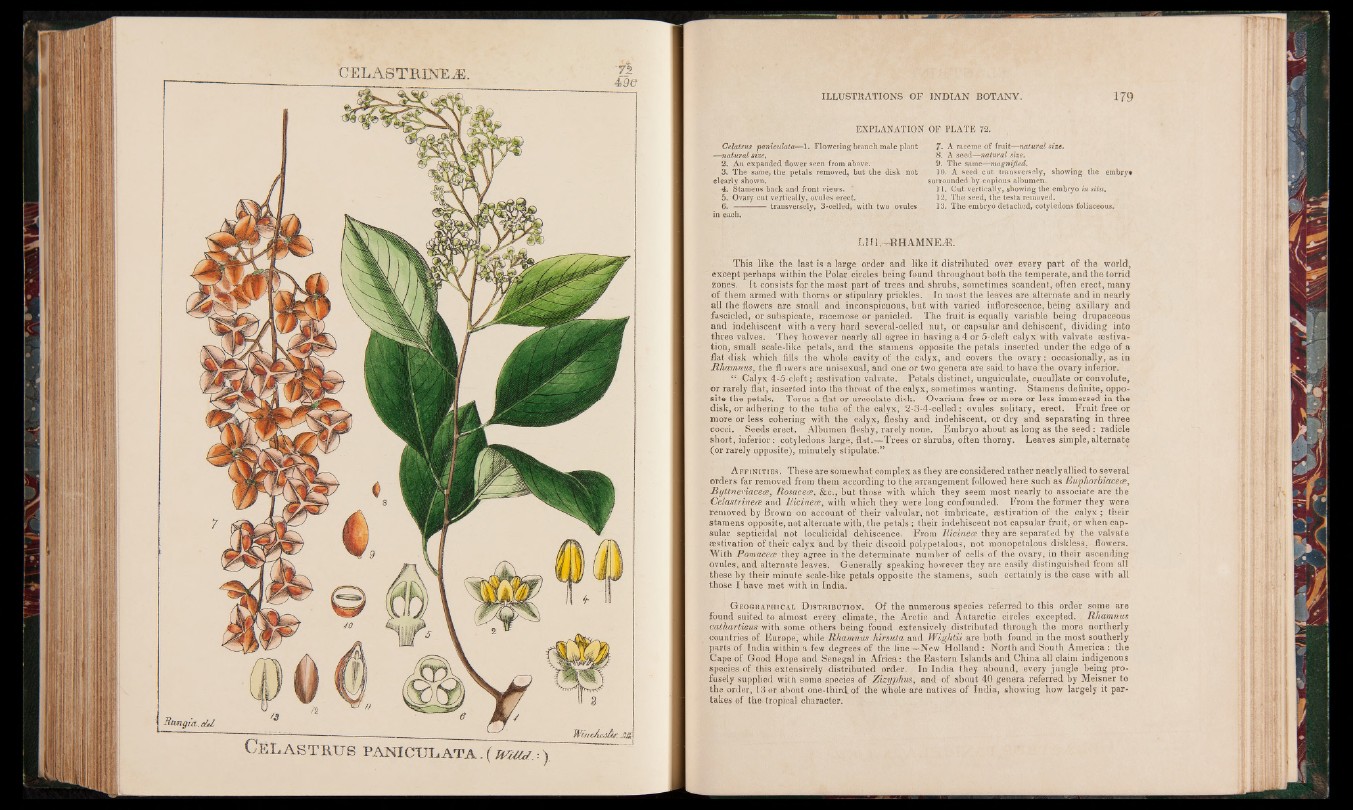
C E L A S T R I N E Æ .
C e L A S T H U S P A N I C U L A T A . ( W M tT . ■
Rungia.. eùl
EXPLANATION OF PLATE 72.
Celatrus paniculata—Is Flowering branch male plant
!—natural size,
2. An expanded flower seen from above.
3. The same, the petals removed, but the disk not
clearly shown.
4. Stamens back and front views.
5. Ovary cut vertically, ovules erect.
6. ------------ transversely, 3-celled, with two ovules
in each.
7. A raceme of fruit—natural size.
8. A seed—natural size.
9. The same—magnified.
10. A seed cut transversely, showing the embryc
surrounded by copious albumen.
11. Cut vertically, showing the embryo in situ.
12. The seed, the testa removed.
13. The embryo detached, cotyledons foliaceous.
LIÜ,—RHAMNEÆ.
This like the last is a large order and like it distributed over every part of the world,
except perhaps within the Polar circles being found throughout both the temperate, and the torrid
zones. It consists for the most part of trees and shrubs, sometimes scandent, often erect, many
of them armed with thorns or stipulary prickles. In most the leaves are alternate and in nearly
all the flowers are small and inconspicuous, but with varied inflorescence, being axillary and
fascicled, or subspicate, racemose or panicled. The fruit is equally variable being drupaceous
and indehiscent with a very hard several-celled nut, or capsular and dehiscent, dividing into
three valves. They however nearly all agree in having a 4 or 5-cleft calyx with valvate aestivation,
small scale-like petals, and the stamens opposite the petals inserted under the edge of a
flat disk which fills the whole cavity of the calyx, and covers the ovary : occasionally, as in
Rhamnus, the flowers are unisexual, and one or two genera ate said to have the ovary inferior.
“ Calyx 4-5-cleft; aestivation valvate. Petals distinct, unguiculate, cucullate or convolute,
or rarely flat, inserted into the throat of the calyx, sometimes wanting. Stamens definite, opposite
the petals. Torus a flat or urceolate disk. Ovarium free or more or less immersed in the
disk, or adhering to the tube of the calyx, 2-3-4-celled: ovules solitary, erect. Fruit free or
more or less cohering with the calyx, fleshy and indehiscent, or dry and separating in three
cocci. Seeds erect. Albumen fleshy, rarely none. Embryo about as long as the seed : radicle
short, inferior : cotyledons large, flat^-Trees or shrubs, often thorny. Leaves simple, alternate
(or rarely opposite), minutely stipulate.”
A f f in i t i e s . These are somewhat complex as they are considered rather nearly allied to several
orders far removed from them according to the arrangement followed here such as Euphorbictcece,
Byttneriacece, Rosacece, &c., but those with which they seem most nearly to associate are the
Celastrinece and llicinece, with which they were long confounded. From the former they were
removed by Brown on account of their valvular, not imbricate, aestivation of the calyx; their
stamens opposite, not alternate with, the petals : their indehiscent not capsular fruit, or when capsular
septicidal not loculicidal dehiscence. From llicinece they are separated by the valvate
aestivation of their calyx and by their discoid polypetalous, not monopetalous diskless, flowers.
With Pomacece they agree in the determinate number of cells of the ovary, in their ascending
ovules, and alternate leaves. Generally speaking however they are easily distinguished from all
these by their minute scale-like petals opposite the stamens, such certainly is the case with all
those I have met with in India.
G e o g r a p h ic a l D is t r ib u t io n . Of the numerous species referred to this order some are
found suited to almost every climate, the Arctic and Antarctic circles excepted. Rhamnus
cathartieus with some others being found extensively distributed through the more northerly
countries of Europe, while Rhamnus hirsuta and Wightii are both found in the most southerly
parts of India within a few degrees of the line—New Holland : North and South America : the
Cape of Good Hope and Senegal in Africa: the Eastern Islands and China all claim indigenous
species of this extensively distributed order. In India they abound, every jungle being profusely
supplied with some species of Zizyphus, and of about 40 genera referred by Meisner to
the order, 13 or about one-third, of the whole are natives of India, showing how largely it partakes
of the tropical character.